The remote operated vehicle (ROV) market is valued at USD 1.9 billion in 2025 and is anticipated to expand to USD 3.9 billion by 2035, with a CAGR of 7.3%. Between 2021 and 2025, the market will grow steadily from USD 1.4 billion to USD 1.9 billion. This phase is driven by the rising demand for ROVs across various industries, including oil and gas, underwater exploration, and defense, where precise, reliable operations in challenging environments are crucial.
The growth in this period is also supported by increasing investments in autonomous technologies and the expansion of offshore operations. During this phase, advancements in ROV technology, including enhanced depth capabilities, real-time data transmission, and increased efficiency, drive greater adoption. This growth is supported by an increasing need for ROVs in deep-sea exploration, infrastructure inspection, and environmental monitoring, providing significant absolute dollar opportunities as new applications emerge and global market penetration increases.
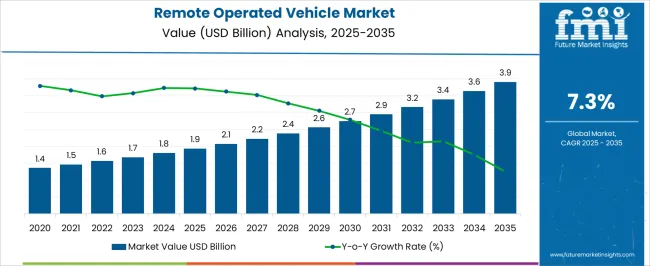
| Metric | Value |
|---|---|
| Remote Operated Vehicle Market Estimated Value in (2025 E) | USD 1.9 billion |
| Remote Operated Vehicle Market Forecast Value in (2035 F) | USD 3.9 billion |
| Forecast CAGR (2025 to 2035) | 7.3% |
The underwater robotics market plays a significant role, contributing about 25-30%, as ROVs are an essential type of robotic system used in various underwater operations such as exploration, inspection, and intervention. The oil and gas industry market is a major driver, accounting for around 35-40%, with ROVs being extensively used for subsea exploration, drilling, pipeline inspection, and maintenance, particularly in environments that are too hazardous for humans.
The marine and maritime industry market contributes approximately 12-15%, as ROVs are crucial for underwater surveying, marine research, shipwreck exploration, and the maintenance of maritime infrastructure. The defense and military market also plays a significant role, with ROVs contributing around 8-10%, as they are used for mine detection, underwater surveillance, reconnaissance, bomb disposal, and hazardous material handling in submerged environments.
The mining industry market accounts for about 7-9%, particularly in deep-sea mining operations, where ROVs are employed for tasks such as material sampling, exploration, and environmental monitoring. These parent markets highlight the diverse applications of ROVs, ranging from industrial and military uses to marine research and deep-sea mining.
The remote operated vehicle market is experiencing robust growth driven by expanding offshore energy exploration, underwater infrastructure maintenance, and environmental monitoring initiatives. Increasing demand for deep sea exploration and inspection in oil and gas, defense, and scientific research has significantly boosted the adoption of advanced ROV systems.
Technological advancements in high definition imaging, autonomous navigation, and improved manipulator arms have enhanced operational efficiency and safety. Rising use of ROVs in offshore wind farm installation and inspection further supports market expansion, as renewable energy infrastructure increasingly requires precise underwater operations.
The outlook remains positive as industries seek cost effective, reliable, and safe alternatives to human divers in hazardous and deep water environments.
The remote operated vehicle market is segmented by class, application, and geographic regions. By class, remote operated vehicle market is divided into Work class ROV, Light work class ROV, Observation class ROV, and Micro/Mini ROV. In terms of application, remote operated vehicle market is classified into Aquaculture, Commercial & Salvage Diving, Municipal Infrastructure, Military, Oil & Energy, and Others. Regionally, the remote operated vehicle industry is classified into North America, Latin America, Western Europe, Eastern Europe, Balkan & Baltic Countries, Russia & Belarus, Central Asia, East Asia, South Asia & Pacific, and the Middle East & Africa.
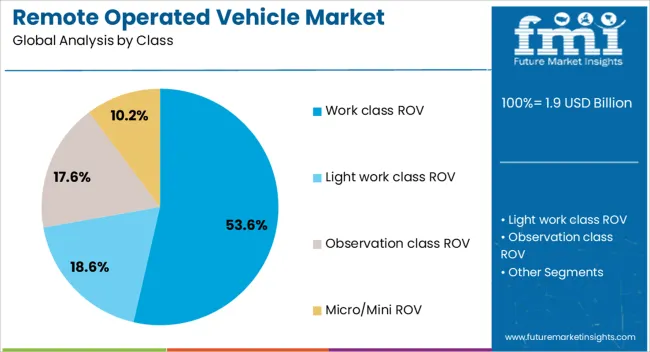
The work class ROV segment is projected to account for 53.60% of total market revenue by 2025 within the class category, making it the dominant segment. This growth is attributed to its ability to perform complex subsea tasks such as heavy lifting, drilling support, and pipeline inspection at extreme depths.
Its robust design, higher payload capacity, and compatibility with a wide range of tooling make it the preferred choice for demanding offshore operations.
The capability to operate in challenging conditions while maintaining precision and safety has reinforced its leadership in the ROV market.

The aquaculture segment is expected to hold 41.80% of the total market revenue by 2025 within the application category, establishing it as the leading segment. This is driven by the increasing adoption of ROVs for underwater inspection, net cleaning, stock monitoring, and infrastructure maintenance in fish farming operations.
The need for non invasive monitoring methods and operational efficiency has promoted the integration of ROVs in aquaculture.
Their ability to reduce manual labor costs, improve inspection accuracy, and ensure livestock health has solidified aquaculture as a major growth area for ROV applications.
The remote operated vehicle (ROV) market is experiencing significant growth, driven by demand in subsea operations, industrial inspections, and defense applications. ROVs provide critical solutions in underwater exploration, offshore oil and gas operations, and deep-sea research. The increasing need for accurate, efficient, and cost-effective underwater inspection and repair capabilities is a major driver. Challenges include high production and maintenance costs, technological advancements, and the complexities of operating in extreme underwater environments.
Opportunities exist in expanding applications across emerging industries like renewable energy, marine archaeology, and defense. Trends indicate growing demand for more advanced ROV systems with improved maneuverability, automation, and higher payload capacity. Suppliers offering innovative, reliable, and cost-effective ROV solutions are well-positioned to capture market growth globally.
The ROV market is being driven by the increasing demand for advanced underwater exploration and inspection solutions in industries such as offshore oil and gas, marine research, and defense. ROVs are crucial for tasks such as pipeline inspections, subsea installations, and marine data collection, offering operators the ability to reach depths and environments that are too hazardous for human divers. The growing need for offshore energy resources, deep-sea exploration, and underwater infrastructure maintenance is fueling the demand for more capable ROV systems. With advancements in automation, ROVs are becoming more efficient in performing complex tasks, contributing to the expansion of their application across multiple industries.
The remote operated vehicle market faces several challenges, particularly related to high production costs, especially for advanced ROV systems capable of operating in extreme underwater conditions. The cost of components, such as high-performance cameras, sensors, and propulsion systems, adds to the overall price of ROVs. Additionally, the complexity of manufacturing and maintaining ROVs, along with the need for continuous technological advancements, creates a challenging operational environment. Regulatory constraints, particularly in offshore operations, further complicate deployment. As the demand for ROVs increases, manufacturers must overcome supply chain challenges, ensure compliance with international standards, and focus on reducing operational costs while maintaining high-performance capabilities.
Opportunities in the ROV market are expanding into new industries such as renewable energy, marine research, and environmental monitoring. The growth of offshore wind energy and the need for underwater maintenance of renewable energy infrastructure are creating significant demand for ROVs with specialized capabilities. Additionally, marine archaeology, underwater robotics, and environmental research are emerging sectors where ROVs are expected to play an increasingly vital role. These industries require ROVs with enhanced autonomy, payload capacity, and specialized equipment, providing manufacturers with opportunities to innovate and cater to new applications. The global shift towards deep-sea exploration and renewable energy is expected to create long-term opportunities for ROV suppliers.
The ROV market is trending toward increased automation, higher payload capacities, and integration of advanced technologies such as AI, machine learning, and autonomous systems. Automation is enabling ROVs to perform more complex tasks with minimal human intervention, improving efficiency and safety in deep-sea operations. The demand for ROVs with higher payload capacities allows them to carry more advanced equipment, such as multi-beam sonar and high-definition cameras, for comprehensive data collection and inspection.The integration of AI and machine learning is enabling ROVs to make autonomous decisions, improving mission efficiency and reducing operational costs. These technological advancements are making ROVs more versatile and valuable across a wide range of industries.
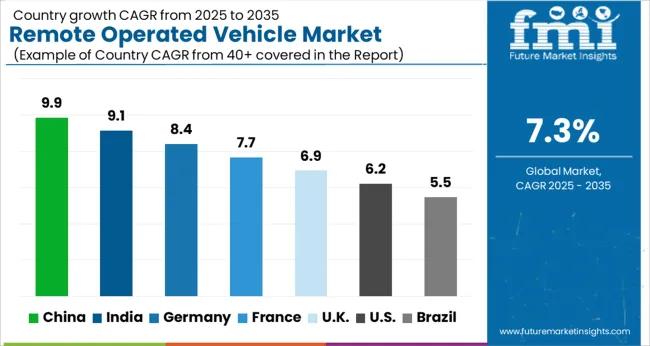
| Country | CAGR |
|---|---|
| China | 9.9% |
| India | 9.1% |
| Germany | 8.4% |
| France | 7.7% |
| UK | 6.9% |
| USA | 6.2% |
| Brazil | 5.5% |
The global remote operated vehicle (ROV) market is projected to grow at a CAGR of 7.3% from 2025 to 2035. China leads with 9.9%, followed by India at 9.1%, and Germany at 8.4%. The UK and USA show more moderate growth rates of 6.9% and 6.2% respectively. Growth is primarily driven by offshore oil and gas exploration, military applications, and the increasing adoption of ROVs in offshore renewable energy projects. Technological advancements in autonomous systems and AI integration are accelerating ROV deployment in defense, commercial, and research sectors. The analysis includes over 40+ countries, with the leading markets detailed below.
The remote operated vehicle (ROV) market in China is set to grow at a CAGR of 9.9% from 2025 to 2035. The country's rapid expansion in offshore oil and gas exploration, along with a significant push toward technological advancements in autonomous underwater vehicles, is driving market growth. With China’s increasing investments in marine infrastructure and deep-sea exploration, the demand for high-quality ROVs is on the rise. The expansion of the maritime industry, encompassing commercial shipping and logistics, further underscores the need for ROVs in surveillance and inspection tasks. Growing defense spending is contributing to the increasing adoption of ROVs for military surveillance, reconnaissance, and underwater operations. The country's development of high-tech underwater robotics for environmental monitoring and resource extraction is another key driver.
The remote operated vehicle (ROV) market in India is expected to grow at a CAGR of 9.1% from 2025 to 2035. The country’s expanding offshore oil and gas exploration sector, alongside the growth of underwater research activities, is driving demand for ROVs. India's maritime industry is evolving, with increasing investments in ports, shipping, and naval defense, all of which require advanced ROVs for inspections, repairs, and maintenance. India’s strategic focus on deep-sea exploration, marine scientific research, and underwater resource extraction is fueling the demand for sophisticated underwater robotic systems. The increasing trend of autonomous ROVs for high-efficiency operations in commercial sectors, such as fishing, oceanography, and infrastructure inspections, is contributing to market growth.
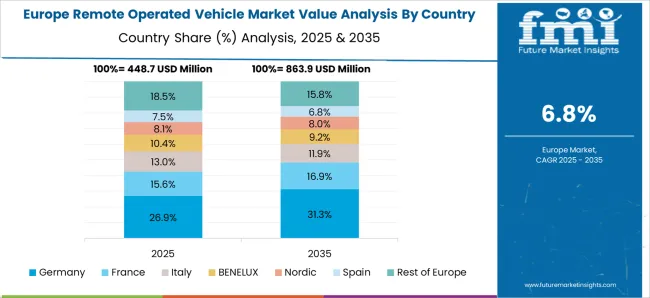
The ROV market in Germany is projected to expand at a CAGR of 8.4% from 2025 to 2035. As a leader in European maritime industries, Germany has seen significant demand for ROVs in offshore energy, particularly offshore wind energy, which requires sophisticated inspection and maintenance. The country’s strong focus on renewable energy projects is creating opportunities for ROVs to support the installation and upkeep of offshore wind turbines and underwater structures. Defense sector is increasingly investing in underwater robotics for naval surveillance, security, and reconnaissance. The growing trend of automation in various industries, such as shipping, logistics, and infrastructure maintenance, is further driving the adoption of ROVs.
The UK remote operated vehicle (ROV) market is expected to grow at a CAGR of 6.9% from 2025 to 2035. The offshore oil and gas exploration sector is a major driver for ROV adoption, with the UK being home to one of the largest offshore energy markets in Europe. Additionally, the country’s growing offshore renewable energy market, particularly wind energy, is driving demand for ROVs for underwater installation, inspection, and maintenance. The UK defense sector also plays a significant role, with an increasing need for ROVs in naval surveillance, maritime security, and tactical operations. As part of the country’s broader commitment to technological advancements, ROVs are being integrated into defense operations, research, and commercial projects. The UK’s continued investment in scientific exploration, environmental monitoring, and underwater archaeology is fueling the demand for sophisticated and durable ROVs.
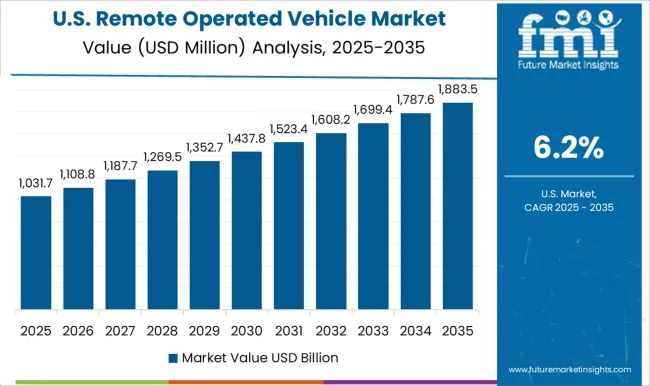
The USA remote operated vehicle (ROV) market is projected to grow at a CAGR of 6.2% from 2025 to 2035. The growth of offshore oil and gas exploration, military applications, and underwater research initiatives primarily drives the demand for ROVs in the USA. The USA has a highly developed offshore industry, which relies heavily on ROVs for deep-sea inspection, repair, and maintenance of underwater assets. Additionally, there is an increasing demand for ROVs in the defense sector for surveillance, reconnaissance, and tactical missions. The USA market also benefits from advancements in autonomous technologies, with ROVs becoming increasingly sophisticated in performing tasks without human intervention. The rise in scientific and environmental research, including oceanography and underwater archaeology, further contributes to the demand for ROVs.

In the remote operated vehicle (ROV) market, competition is driven by technological innovation, operational depth, and industry-specific applications. Oceaneering International is a market leader, offering a wide range of ROVs for subsea exploration, inspection, and intervention. The company emphasizes high-performance vehicles capable of deepwater operations and complex tasks, catering primarily to the oil and gas, defense, and marine sectors. Saab Seaeye competes by providing technologically advanced, electric-powered ROVs, known for their compact design and versatility in both shallow and deepwater environments. Their products are widely used in offshore inspections, construction support, and survey applications. Deep Trekker distinguishes itself with portable and user-friendly ROVs designed for underwater inspection tasks across industries like aquaculture, utilities, and environmental monitoring. Their systems are well-regarded for their ease of operation and compact design, allowing for use in confined spaces. VideoRay focuses on mini and micro ROVs, offering lightweight, portable vehicles primarily used for security, defense, and survey missions.
| Item | Value |
|---|---|
| Quantitative Units | USD 1.9 Billion |
| Class | Work class ROV, Light work class ROV, Observation class ROV, and Micro/Mini ROV |
| Application | Aquaculture, Commercial & Salvage Diving, Municipal Infrastructure, Military, Oil & Energy, and Others |
| Regions Covered | North America, Europe, Asia-Pacific, Latin America, Middle East & Africa |
| Country Covered | United States, Canada, Germany, France, United Kingdom, China, Japan, India, Brazil, South Africa |
| Key Companies Profiled | Oceaneering, Saab Seaeye, Deep Trekker, VideoRay, Total Marine Technology, TechnipFMC, Forum Energy Technologies, SEAMOR, Subsea 7, and DOF Subsea |
| Additional Attributes | Dollar sales by ROV type (electric, hydraulic, inspection, work-class), application (oil and gas, offshore construction, environmental monitoring), and depth capability (shallow, deepwater). Demand is driven by advancements in subsea exploration, inspection needs, and rising offshore energy projects. Regional trends indicate strong growth in North America, Europe, and Asia-Pacific, with the oil and gas industry’s need for cost-effective and reliable underwater solutions driving adoption. |
The global remote operated vehicle market is estimated to be valued at USD 1.9 billion in 2025.
The market size for the remote operated vehicle market is projected to reach USD 3.9 billion by 2035.
The remote operated vehicle market is expected to grow at a 7.3% CAGR between 2025 and 2035.
The key product types in remote operated vehicle market are work class rov, light work class rov, observation class rov and micro/mini rov.
In terms of application, aquaculture segment to command 41.8% share in the remote operated vehicle market in 2025.






Full Research Suite comprises of:
Market outlook & trends analysis
Interviews & case studies
Strategic recommendations
Vendor profiles & capabilities analysis
5-year forecasts
8 regions and 60+ country-level data splits
Market segment data splits
12 months of continuous data updates
DELIVERED AS:
PDF EXCEL ONLINE
Remote Lockout Tool Market Size and Share Forecast Outlook 2025 to 2035
Remote Desktop Software Market Forecast and Outlook 2025 to 2035
Remote Patient Monitoring Devices Market Size and Share Forecast Outlook 2025 to 2035
Remote Assist Headrest Market Size and Share Forecast Outlook 2025 to 2035
Remote Endarterectomy Devices Market Size and Share Forecast Outlook 2025 to 2035
Remote Electrocardiogram Monitoring Market Size and Share Forecast Outlook 2025 to 2035
Remote Valve Tissue Expanders Market Size and Share Forecast Outlook 2025 to 2035
Remote Patient Monitoring System Market Size and Share Forecast Outlook 2025 to 2035
Remote Imaging Collaboration Market Analysis - Size, Share, and Forecast Outlook 2025 to 2035
Remote DC Microgrid Market Size and Share Forecast Outlook 2025 to 2035
Remote Microgrid Market Size and Share Forecast Outlook 2025 to 2035
Remote Towers Market Size and Share Forecast Outlook 2025 to 2035
Remote AF Detection Tools Market Analysis Size and Share Forecast Outlook 2025 to 2035
Remote Home Monitoring Systems Market Size and Share Forecast Outlook 2025 to 2035
Remote Asset Management Market Size and Share Forecast Outlook 2025 to 2035
Remote Learning Technology Spending Market Analysis by Technology Software, Technology Services, Learning Mode, End User and Region Through 2025 to 2035
Remote Sensing Services Market Trends - Growth & Forecast 2025 to 2035
Remote Cooled Cube Ice Machines Market – Advanced Refrigeration & Industry Growth 2025 to 2035
Remote Healthcare Market - Growth & Innovations 2025 to 2035
Remote Construction Market Analysis by Component, Application, End-use Industry and Region Through 2035

Thank you!
You will receive an email from our Business Development Manager. Please be sure to check your SPAM/JUNK folder too.
Chat With
MaRIA